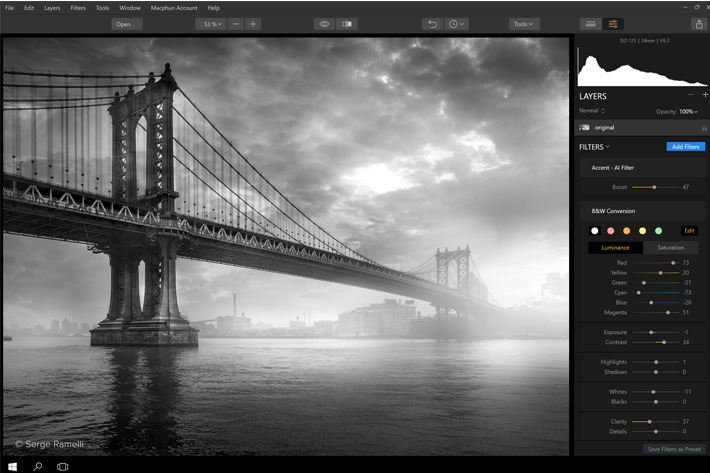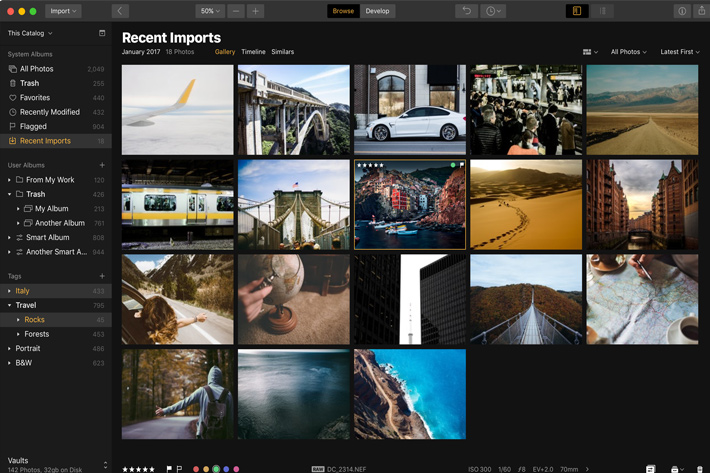
New users will be able to purchase Luminar 2018 for $59, no subscription, while current users of Luminar may upgrade at a special price of $39. The program is on pre-order now.
The recent announcement by Adobe that Lightroom will not have further editions with a perpetual license, making new versions only available through a subscription plan, made many people hastly look for alternatives which, in fact, have been around for quite some time. I’ve covered multiple here at PVC, in previous articles, throughtout recent years. Apparently Adobe is closing down a 10 year path that made Lightroom what is it today, and this gives other players even more reasons to expand their programs and ambitions.
Luminar 2018 is an example of what is available as an alternative for photographers. Initially only available for Mac, and now a Windows program too, a trend we’ve seen in programs as Affinity Photo, for example, Luminar represents a new generation of photo editing program, one with a simple goal: enable the best-looking images with the least amount of effort.
We’re living some exciting times, as photographers, with so many programs to choose from. From more classic solutions to those as Luminar 2018, which delivers a breakthrough photo editing experience for photographers on Mac & Windows with new filters, tools, non-destructive editing, major speed boosts, and a digital asset management platform that will arrive in 2018, we’ve reached a point where photographers can pick the program that best suits their needs and style.

There is a learning curve to most of these new programs, as they depart from the logic we’ve grown used to for a long time, offering new tricks and solutions when editing photographs. While interfaces may seem similar, and they partially are, there are new features that need some time getting used to, and somewhere along the way you may feel like giving up. Believe me, time invested to discover how these new programs work may well be a rewarding experience in the end. Remember how strange Lightroom was, when it first appeared?
Let me take you through some of the features present in the program, using Macphun’s own words and some of the notes I’ve published before about Luminar. Re-built from the ground up for dramatic performance boost over previous versions, the program uses a streamlined user interface that takes some time to grasp, because of three things: it’s different, it gives you access to tons of things, and it mixes Photoshop, Lightroom and a whole collection of plugins all under the same name.
In fact, Luminar 2018 offers everything a modern photographer needs for photo editing, including new filters powered by artificial intelligence, major speed improvements, a dedicated RAW develop module and, as Macphun promised recently, a forthcoming in 2018 digital asset management platform. Users will also benefit from the new intelligent Sun Rays filter, LUT support, and real-time noise removal. With adaptive workspaces that match styles of shooting, Luminar adapts to deliver a complete experience that avoids clutter and complexity.
“We’ve taken the time to listen to photographers, and what they want is performance and quality. The less time photographers have to spend in front of computers, the more time they have for taking pictures,” said Alex Tsepko, CEO of Macphun. “Our mission is to get Luminar streamlined with just the tools and controls photographers need. The goal is simple: enable the best-looking images with the least amount of effort.”
Luminar offers a new RAW Engine that can handle high-quality images faster. Plus, it’s easy to solve image problems caused by camera lenses with Lens Correction features that resolve vignette, distortion, and color aberrations. If the photo has unwanted perspective problems, a new Transform tool can quickly solve them.
Instead of stuffing menus with boring effects and old technology, Luminar only puts in filters that photographers want and need. Luminar offers more than 40 filters to correct color, sharpen details, and release creativity. New filters include the ability to enhance color with Brilliance, selectively lighten or darken specific areas of an image with Dodge & Burn, as well as the ability to change the lighting in a photo with Sun Rays.
Want a whole new way to stylize images? Try the new Lookup Table adjustments. Creative color, perfect black and white conversions, and even digital films stocks are just a click away. Lightroom users who rely on custom presets created for Lightroom can also easily convert those presets into LUTs (with a free 3rd party tool) and use them inside of Luminar 2018.
While Luminar is a full featured stand-alone application, users may also choose to install and run it as a plug-in for Photoshop and Lightroom, or as an extension to Apple Photos. On October 2017, Luminar was awarded with the Lucie Technical Awards for Best Software Plugin.
Luminar 2018 is available now, and in 2018 a free update will provide a new image-browser / digital asset manager to help photographers manage their image libraries. Photographers will be able to sort, rate, organize, and backup their photos at great speed. The new digital asset management platform in Luminar will work without subscription and will work with any storage (cloud or local). It will also bring a number of unique features, that the current Lightroom library can’t boast.
https://youtu.be/9FCHmJiF894
Pre-order for Luminar 2018 will run until November 16. Pre-order customers will receive a special price and value-add bonuses including a pack of signature presets & textures from a Pro photographer Nicolesy (Nicole S. Young), an exclusive pack of LUTs and 1-year Power plan from SmugMug ($72 value), for new accounts only.
Current users of Luminar may upgrade at a special pre-order price of $39, users of Luminar beta for Windows may upgrade at a special preorder price of $49 and new users can purchase Luminar at a special pre-order price of $59. It is important to remember, too, that mixed-computer households can share the same product key for Mac and PC which can be activated on five devices.
As part of the development of the new photo editor, Macphun, the company behind Luminar 2018 and Aurora HDR announced recently it will change its name to Skylum, and wants to be an alternative to Adobe when it comes to photographers.

